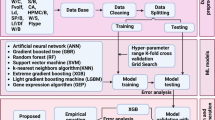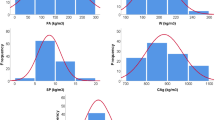Abstract
An artificial neural network (ANN) has a wide application field for mathematical problems. Specifically, an ANN is successfully applied to problems that are difficult to solve or do not have any information on their operating techniques. In this article, an ANN was applied to predict the concrete mix composition for steel fiber-reinforced concrete (SFRC). Thus, an ANN model was developed and trained with data collected from literature. These data have SFRC mix compositions, workability measurements of fresh SFRC, compressive strength of SFRCs, and additional information that affects concrete quality. Additionally, the ANN included steel fiber volume fraction in the SFRC and steel fiber properties. With the goal of determining the concrete mix composition, which is cement dosage, amount of water, coarse aggregate content, fine aggregate content, and chemical admixture, an ANN model was developed. The inputs for the ANN were consistency class of SFRC, compressive strength of SFRC, maximum size of aggregate, steel fiber volume fraction, steel fiber length, and diameter. At the end of the study, a feed forward ANN model with six inputs and five outputs was successfully trained and used to produce the correct responses to testing data. Designing SFRC requires more trial mixtures to obtain the desired quality than does conventional concrete. In conclusion, artificial neural networks have a strong potential for predicting concrete mix composition for SFRC such that without trial mixes and loss of time, an SFRC design is possible with the desired workability and mechanical properties.
Similar content being viewed by others
References
Mehta P.K., Monteiro P.J.M.: Concrete: Microstructure, Properties and Materials. McGraw-Hill, New York (2006)
ACI Committee 544. State-of-the-art report on fiber reinforced concrete. ACI 544.1R-96 (Reapproved 2005), Manual of Concrete Practice. American Concrete Institute, Michigan (2002)
Bentur A., Mindess S.: Fiber Reinforced Cementitious Composites. Elsevier Science Publishing, New York (2005)
Ince R.: Prediction of fracture parameters of concrete by artificial neural networks. Eng. Fract. Mech. 71, 2143–2159 (2004)
Sarıdemir M.: Prediction of compressive strength of concretes containing metakaolin and silica fume by artificial neural networks. Adv. Eng. Softw. (2009). doi:10.1016/j.advengsoft.2008.05.002
Sarıdemir M.: Predicting the compressive strength of mortars containing metakaolin by artificial neural networks and fuzzy logic. Adv. Eng. Softw. (2009). doi:10.1016/j.advengsoft.2008.12.008
Bilim C., Atis C.D., Tanyildizi H., Karahan O.: Predicting the compressive strength of ground granulated blast furnace slag concrete using artificial neural network. Adv. Eng. Softw. (2009). doi:10.1016/j.advengsoft.2008.05.005
Boukli Hacene S.M.A., Ghomari F., Schoefs F., Khelidj A.: Probabilistic modelling of compressive strength of concrete using response surface methodology and neural networks. Arab. J. Sci. Eng. (2014). doi:10.1007/s13369-014-1139-y
Sahin U., Bedirhanoglu I.: A fuzzy model approach to stress–strain relationship of concrete in compression. Arab. J. Sci. Eng. (2014). doi:10.1007/s13369-014-1170-z
BingölA.F.; Tortum A., Gül R.: Neural networks analysis of compressive strength of lightweight concrete after high temperatures. Mater. Des. (2013). doi:10.1016/j.matdes.2013.05.022
Topcu I.B., Sarıdemir M.: Prediction of compressive strength of concrete containing fly ash using artificial neural networks and fuzzy logic. Comput. Mater. Sci. (2008). doi:10.1016/j.commatsci.2007.04.009
Sarıdemir, M.; Topçu, I.B.; Özcan, F.; Severcan, M.H.: Prediction of long-term effects of GGBFS on compressive strength of concrete by artificial neural networks and fuzzy logic. Constr. Build. Mater. (2009). doi:10.1016/j.commatsci.2007.04.009
Uysal M., Tanyildizi H.: Estimation of compressive strength of self-compacting concrete containing polypropylene fiber and mineral additives exposed to high temperature using artificial neural network. Constr. Build. Mater. (2012). doi:10.1016/j.conbuildmat.2011.07.028
Ren L., Zhao Z.: An optimal neural network and concrete strength modeling. Adv. Eng. Softw. (2002). doi:10.1016/S0965-9978(02)00005-4
Özcan, F.; Atis, C.D.; Karahan, O.; Uncuoglu, E.; Tanyildizi, H.: Comparison of artificial neural network and fuzzy logic models for prediction of long-term compressive strength of silica fume concrete.Adv. Eng. Softw. (2009). doi:10.1016/j.advengsoft.2009.01.005
Topcu I.B., Sarıdemir M.: Prediction of properties of waste AAC aggregate concrete using artificial neural network. Comput. Mater. Sci. (2007). doi:10.1016/j.commatsci.2007.03.010
Topcu I.B., Sarıdemir M.: Prediction of rubberized concrete properties using artificial neural network and fuzzy logic. Constr. Build. Mater. (2008). doi:10.1016/j.conbuildmat.2006.11.007
Topcu I.B., Sarıdemir M.: Prediction of mechanical properties of recycled aggregate concretes containing silica fume using artificial neural networks and fuzzy logic. Comput. Mater. Sci. (2008). doi:10.1016/j.commatsci.2007.06.011
Bai J., Wild S., Ware J.A., Sabir B.B.: Using neural networks to predict workability of concrete incorporating metakaolin and fly ash. Adv. Eng. Softw. (2003). doi:10.1016/S0965-9978(03)00102-9
Gencel O., Kocabas F., Gok M.S., Koksal F.: Comparison of artificial neural networks and general linear model approaches for the analysis of abrasive wear of concrete. Constr. Build. Mater. (2011). doi:10.1016/j.conbuildmat.2011.03.040
Chandwani V., Agrawal V., Nagar R.: Modeling slump of ready mix concrete using genetic algorithms assisted training of artificial neural networks. Expert Syst. Appl. (2015). doi:10.1016/j.eswa.2014.08.048
Ji T., Lin T., Lin X.: A concrete mix proportion design algorithm based on artificial neural networks. Cem. Concr. Res. (2006). doi:10.1016/j.cemconres.2006.01.009
Altun F., Kişi O., Aydin K.: Predicting the compressive strength of steel fiber added lightweight concrete using neural network. Comput. Mater. Sci. (2008). doi:10.1016/j.commatsci.2007.07.011
Ashrafi H.R., Jalal M., Garmsiri K.: Prediction of load–displacement curve of concrete reinforced by composite fibers (steel and polymeric) using artificial neural network. Expert Syst. Appl. (2010). doi:10.1016/j.eswa.2010.04.076
Padmarajaiah S.K., Ramaswamy A.: Flexural strength predictions of steel fiber reinforced high-strength concrete in fully/partially prestressed beam specimens. Cem. Concr. Compos. (2004). doi:10.1016/S0958-9465(02)00121-X
Kumar S., Barai S.V.: Neural networks modeling of shear strength of SFRC corbels without stirrups. Appl. Soft Comput. (2010). doi:10.1016/j.asoc.2009.06.012
Adhikary B.B., Mutsuyoshi H.: Prediction of shear strength of steel fiber RC beams using neural networks. Constr. Build. Mater. (2006). doi:10.1016/j.conbuildmat.2005.01.047
Köksal F., Şahin Y., Beycioğlu A., Gencel O., Brostow W.: Estimation of fracture energy of high strength steel fiber reinforced concrete using rule based mamdani type fuzzy inference system. Sci. Eng. Compos. Mater. (2012). doi:10.1515/secm-2012-0017
Brandt A.M.: Fiber reinforced cement-based (FRC) composites after over 40 years of development in building and civil engineering. Compos. Struct. (2008). doi:10.1016/j.compstruct.2008.03.006
Romualdi J.P., Batson G.B.: Mechanics of crack arrest in concrete. J. Eng. Mech. Div. ASCE Proc. 89, 147–168 (1963)
Romualdi J.P., Mandel J.A.: Tensile strength of concrete affected by uniformly distributed and closely spaced short lengths of wire reinforcement. J. ACI 61(6), 657–671 (1964)
Banthia N., Sappakittipakorn M.: Toughness enhancement in steel fiber reinforced concrete through fiber hybridization. Cem. Concr. Res. (2007). doi:10.1016/j.cemconres.2007.05.005
Nataraja M.C., Dhang N., Gupta A.P.: Stress–strain curves for steel-fiber reinforced concrete under compression. Cem. Concr. Compos. (1999). doi:10.1016/S0958-9465(99)00021-9
Gopalaratnam V.S., Gettu R.: On the characterization of flexural toughness in fiber reinforced concretes. Cem. Concr. Compos. (1995). doi:10.1016/0958-9465(95)99506-O
Uygunoglu T.: Effect of fiber type and content on bleeding of steel fiber reinforced concrete. Constr. Build. Mater. (2011). doi:10.1016/j.conbuildmat.2010.07.008
Mohammadi Y., Singh S.P., Kaushik S.K.: Properties of steel fibrous concrete containing mixed fibers in fresh and hardened state. Constr. Build. Mater. (2008). doi:10.1016/j.conbuildmat.2006.12.004
Shah S.P., Rangan B.V.: Fiber reinforced concrete properties. ACI J. Proc. 68, 126–135 (1971)
Chen W.F., Carson J.L.: Stress–strain properties of random wire reinforced concrete. ACI J. Proc. 68, 797–804 (1971)
Altun F., Haktanir T., Ari K.: Effects of steel fiber addition on mechanical properties of concrete and RC beams. Constr. Build. Mater. (2007). doi:10.1016/j.conbuildmat.2005.12.006
Olivito R.S., Zuccarello F.A.: An experimental study on the tensile strength of steel fiber reinforced concrete. Compos. Part B (2010). doi:10.1016/j.compositesb.2009.12.003
Parichatprecha R., Nimityongskul P.: Analysis of durability of high performance concrete using artificial neural networks. Constr. Build. Mater. (2009). doi:10.1016/j.conbuildmat.2008.04.015
Elmas C.: Artificial Intelligence Applications. Seckin, Ankara (in Turkish) (2007)
Oztas A., Pala M., Ozbay E., Kanca E., Caglar N., Bhatti M.A.: Predicting the compressive strength and slump of high strength concrete using neural network. Constr. Build. Mater. (2006). doi:10.1016/j.conbuildmat.2005.01.054
Topcu I.B., Karakurt C., Sarıdemir M.: Predicting the strength development of cements produced with different pozzolans by neural network and fuzzy logic. Mater. Des. (2008). doi:10.1016/j.matdes.2008.04.005
Gencel O.: The application of artificial neural networks technique to estimate mass attenuation coefficient of shielding barrier. Int. J. Phys Sci. 4(12), , 743–751 (2009)
Mukherjee A., Biswas S.N.: Artificial neural networks prediction of mechanical behavior of concrete at high temperature. Nucl. Eng. Des. (1997). doi:10.1016/S0029-5493(97)00152-0
Pala M., Ozbay E., Oztas A., Yuce M.I.: Appraisal of long-term effects of fly ash and silica fume on compressive strength of concrete by neural networks. Constr. Build. Mater. (2007). doi:10.1016/j.conbuildmat.2005.08.009
Koksal F., Ilki A., Tasdemir M.A.: Optimum mix design of steel-fibre-reinforced concrete plates. Arab. J. Sci. Eng. (2013). doi:10.1007/s13369-012-0468-y
Yalcin, M.: Optimization and Performance Based Design of Steel Fiber Reinforced Concretes. Doctoral thesis, Istanbul Technic University, Civil Engineering Faculty (1994)
Nili M., Afroughsabet V.: Combined effect of silica fume and steel fibers on the impact resistance and mechanical properties of concrete. Int. J. Impact Eng. (2010). doi:10.1016/j.ijimpeng.2010.03.004
Nguyen-Minh, L.; Rovnak, M.; Tran-Quoc, T.; Nguyenkim, K.: Punching Shear Resistance of Steel Fiber Reinforced Concrete Flat Slabs. In: Proceedings of The Twelfth East Asia-Pacific Conference on Structural Engineering and Construction. Procedia Engineering. (2011). doi: 10.1016/j.proeng.2011.07.230
Ibrahim, I.S.; Che Bakar, M.B.: Effects on mechanical properties of industrialised steel fibers addition to normal weight concrete. In: Proceedings of The Twelfth East Asia-Pacific Conference on Structural Engineering and Construction. Procedia Engineering. (2011). doi: 10.1016/j.proeng.2011.07.329
Eren O., Marar K.: Effects of limestone crusher dust and steel fibers on concrete. Constr. Build. Mater. (2009). doi:10.1016/j.conbuildmat.2008.05.014
Sahin Y., Koksal F.: The influences of matrix and steel fiber tensile strengths on the fracture energy of high-strength concrete. Constr. Build. Mater. (2011). doi:10.1016/j.conbuildmat.2010.11.084
Buratti N., Mazzotti C., Savoia M.: Post-cracking behaviour of steel and macro-synthetic fiber-reinforced concretes. Constr. Build. Mater. (2011). doi:10.1016/j.conbuildmat.2010.12.022
Lau A., Anson M.: Effect of high temperatures on high performance steel fiber reinforced concrete. Cem. Concr. Res. (2006). doi:10.1016/j.cemconres.2006.03.024
Shakya K., Watanabe K., Matsumoto K., Niwa J.: Application of steel fibers in beam–column joints of rigid-framed railway bridges to reduce longitudinal and shear rebars. Constr. Build. Mater. (2012). doi:10.1016/j.conbuildmat.2011.07.016
Soulioti D.V., Barkoula N.M., Paipetis A., Matikas T.E.: Effects of fiber geometry and volume fraction on the flexural behaviour of steel-fiber reinforced concrete. Strain (2011). doi:10.1111/j.1475-1305.2009.00652.x
Unal O., Demir F., Uygunoglu T.: Fuzzy logic approach to predict stress–strain curves of steel fiber-reinforced concretes in compression. Build. Environ. (2007). doi:10.1016/j.buildenv.2006.10.023
Carmona S., Aguado A., Molins C.: Characterization of the properties of steel fiber reinforced concrete by means of the generalized Barcelona test. Constr. Build. Mater. (2013). doi:10.1016/j.conbuildmat.2013.07.060
Cantin R., Pigeon M.: Deicer salt scaling resistance of steel-fiber-reinforced concrete. Cem. Concr. Res. (1996). doi:10.1016/S0008-8846(96)00162-7
Pigeon M., Cantin R.: Flexural properties of steel fiber-reinforced concretes at low temperatures. Cem. Concr. Compos. (1998). doi:10.1016/S0958-9465(98)00017-1
TS 802. Design Concrete Mixes. Turkish Standards Institutions, Ankara (2009)
ASTM C685/C685M. Standard Specification for Concrete Made by Volumetric Batching and Continuous Mixing. Annual Book of ASTM Standards, USA (2011)
ACI Committee 211. Standard practice for selecting proportions for normal, heavyweight, and mass concrete. ACI 211.1-91 (Reapproved 2009), ACI Manual of Concrete Practice. American Concrete Institute, Michigan (1996)
Erdogan T.Y.: Concrete. METU Press, Ankara (2007)
Author information
Authors and Affiliations
Corresponding author
Rights and permissions
About this article
Cite this article
Açikgenç, M., Ulaş, M. & Alyamaç, K.E. Using an Artificial Neural Network to Predict Mix Compositions of Steel Fiber-Reinforced Concrete. Arab J Sci Eng 40, 407–419 (2015). https://doi.org/10.1007/s13369-014-1549-x
Received:
Accepted:
Published:
Issue Date:
DOI: https://doi.org/10.1007/s13369-014-1549-x




